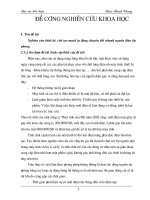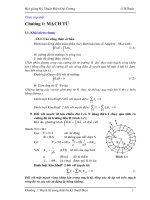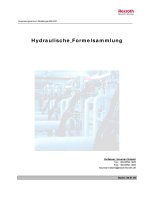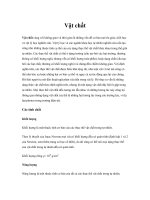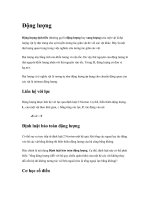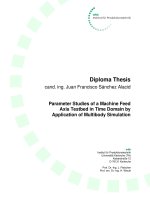Tài liệu Casting P1 docx
Bạn đang xem bản rút gọn của tài liệu. Xem và tải ngay bản đầy đủ của tài liệu tại đây (1.25 MB, 40 trang )
ASM
INTERNATIONAL ®
The Materials
Information Company
Publication Information and Contributors
Casting was published in 1988 as Volume 15 of the 9th Edition Metals Handbook. With the second printing (1992), the
series title was changed to ASM Handbook. The Volume was prepared under the direction of the ASM Handbook
Committee.
Volume Chair
The Volume Chair was D.M. Stefanescu.
Authors and Reviewers
• Rafael Menezes Nunes UFRGS
• G. J. Abbaschian University of Florida
• Harvey Abramowitz Purdue University
• R. Agarwal General Motors Technical Center
• Mark J. Alcini Williams International
• Robert L. Allen Deere & Company
• Richard L. Anderson Arnold Engineering Company
• John Andrews Camden Castings Center
• James J. Archibald Ashland Chemical Company
• Shigeo Asai Nagoya University (Japan)
• William H. Bailey Cleveland Pneumatic Company
• Leo J. Baran American Foundrymen's Society, Inc.
• W.J. Barice Precision Castparts Corporation
• Charles E. Bates Southern Research Institute
• Robert J. Bayuzick Vanderbilt University
• J. Beech University of Sheffield (Great Britain)
• V.G. Behal Dofasco Inc. (Canada)
• P. Belding Columbia Steel Casting Company
• John T. Berry University of Alabama
• U. Betz Leybold AG (West Germany)
• Gopal K. Bhat Bhat Technology International, Inc.
• Yves Bienvenu Ecole des Mines de Paris (France)
• H.E. Bills Reynolds Metals Company Reynolds Aluminum
• Charles R. Bird Stainless Steel Foundry & Engineering Inc.
• K.E. Blazek Inland Steel Company
• William J. Boettinger National Bureau of Standards
• M.A. Bohlmann I.G. Technologies, Inc.
• Charles B. Boyer Battelle Columbus Division
• Jose R. Branco Colorado School of Mines
• R. Brink Leybold AG (West Germany)
• William Brouse Carpenter Technology Corporation
• Roger B. Brown Disamatic, Inc.
• Francis Brozo Hitchcock Industries, Inc.
• Robert S. Buck International Magnesium Consultants, Inc.
• J. Bukowski General Motors Technical Center
• Wilhelm Burgmann Leybold AG (West Germany)
• H.I. Burrier The Timken Company
• Michael Byrne Homer Research Laboratories
• S.L. Camacho Plasma Energy Corporation
• Paul G. Campbell ALUMAX of South Carolina
• James A. Capadona Signicast Corporation
• C. Carlsson Asea Brown Boveri, Inc.
• James H. Carpenter Pangborn Corporation
• Sam F. Carter Carter Consultants, Inc.
• Dixon Chandley Metal Casting Technology, Inc.
• K.K. Chawla New Mexico Institute of Technology
• Dianne Chong McDonnell Douglas Astronautics Company
• A. Choudhury Leybold AG (West Germany)
• Richard J. Choulet Steelmaking Consultant
• Yeou-Li Chu The Ohio State University
• Dwight Clark Baltimore Specialty Steels
• Steve Clark R.H. Sheppard Company, Inc.
• Byron B. Clow International Magnesium Consultants, Inc.
• Arthur Cohen Copper Development Association, Inc.
• B. Cole Fort Wayne Foundry Corporation
• H.H. Cornell Niobium Products Company, Inc.
• James A. Courtois ALUMAX Engineered Metal Processes, Inc.
• Jim Cox Hatch Associates Ltd.
• D.B. Craig Elkem Metals Company
• Alan W. Cramb Carnegie Mellon University
• R. Creese West Virginia University
• T.J. Crowley Microwave Processing Systems
• Milford Cunningham Stahl Specialty Company
• Peter A. Curreri NASA Marshall Space Flight Center
• Michael J. Cusick Colorado School of Mines
• Johnathan A. Dantzig University of Illinois at Urbana--Champaign
• C.V. Darragh The Timken Company
• A.S. Davis ESCO Corporation
• Jackson A. Dean Cardinal Service Company
• Prateen V. Desai Georgia Institute of Technology
• B.K. Dhindaw IIT Kharagpur (India)
• W. Dietrich Leybold AG (West Germany)
• George Di Sylvestro American Colloid Company
• R. L. Dobson The Centrifugal Casting Machine Company
• George J. Dooley, III United States Department of the Interior
• J.L. Dorcic IIT Research Institute
• R. Doremus Rensselaer Polytechnic Institute
• G. Doughman Casting Design and Services
• B. Duca Duca Remanufacturing Inc.
• J. DuPlessis Crucible Magnetics Division
• F. Durand Centre National de la Recherche Scientifique Polytechnique de Grenoble (France)
• William B. Eisen Crucible Compaction Metals
• Nagy El-Kaddah University of Alabama
• R. Elliott University of Manchester (Great Britain)
• John M. Eridon Howmet Corporation
• R.C. Eschenbach Retech, Inc.
• N. Eustathopoulos Institut National Polytechnique de Grenoble (France)
• M. Evans Cytemp Specialty Steels
• Robert D. Evans ALUMAX Engineered Metal Processes, Inc.
• Daniel Eylon University of Dayton
• H.E. Exner Max-Planck-Institut für Metallforschung (West Germany)
• Gilbert M. Farrior ALUMAX Engineered Metal Processes, Inc.
• J. Feroe G.H. Hensley Industries Inc.
• J. Feinman Technical Consultant
• Merton C. Flemings Massachusetts Institute of Technology
• S.C. Flood Alcan International Ltd. (Great Britain)
• Victor K. Forsberg Quanex
• Robert C. Foyle Herman-Sinto V-Process Corporation
• H. Frederiksson The Royal Institute of Technology (Sweden)
• Richard J. Fruehan Carnegie Mellon University
• B. Gabrielsson Elwood Uddeholm Steel Company
• D.R. Gaskell Purdue University
• William Gavin Hitchcock Industries, Inc.
• H. Gaye Technical Consultant
• M. Geiger Asea Brown Boveri, Inc.
• L. Gonano National Forge Company
• George Good Ford Motor Company
• George M. Goodrich Taussig Associates, Inc.
• Martha Goodway Smithsonian Institution
• P. Gouwens CMI Novacast Inc.
• J. Grach Cominco Metals
• L.D. Graham PCC Airfoils
• E.J. Grandy H. Kramer & Company
• Douglas A. Granger Alcoa Technical Center
• C.V. Grosse Howmet Corporation
• R.E. Grote Missouri Precision Castings
• Daniel B. Groteke Metcast Associates, Inc.
• Thomas E. Grubach Aluminum Company of America
• J.E. Gruzleski McGill University (Canada)
• Richard B. Gundlach Climax Research Services
• T.B. Gurganus Alcoa Technical Center
• Alex M. Gymarty SKW Metals & Alloys, Inc.
• David Hale Ervin Industries, Inc.
• T.C. Hansen Trane Company
• Michael J. Hanslits Precision Castparts Corporation
• Howard R. Harker A. Johnson Metals Corporation
• Ron Harrison Cameron Forge Company
• Richard Helbling Northern Castings
• H. Henein Carnegie Mellon University
• D.G. Hennessy The Timken Company
• John J. Henrich United States Pipe and Foundry Company
• W. Herman Quanex
• Edwin Hodge Degussa Electronics Inc.
• D. Hoffman National Forge Company
• George B. Hood United Technologies Pratt & Whitney
• M.J. Hornung Elkem Metals Company
• Robert A. Horton PCC Airfoils, Inc.
• Daryl F. Hoyt Wedron Silica Company
• I.C.H. Hughes BCIRA International Centre for Cast Metals Technology (Great Britain)
• R. Hummer Austrian Foundry Research Institute (Austria)
• James Hunt Southern Aluminum Company
• J.D. Hunt University of Oxford (Great Britain)
• W.-S. Hwang National Cheng Kung University (Taiwan)
• J.E. Indacochea University of Illinois
• K. Ito Carnegie Mellon University
• K.A. Jackson AT&T Bell Laboratories
• J.D. Jackson Pratt & Whitney
• N. Janco Technical Consultant
• H. Jones University of Sheffield (Great Britain)
• M. Jones Duriron Company, Inc.
• J.L. Jorstad Reynolds Aluminum
• David P. Kanicki American Foundrymen's Society
• Seymour Katz General Motors Research Laboratories
• T.L. Kaveney Technical Consultant
• Avery Kearney Avery Kearney & Company
• H. Kemmer Leybold AG (West Germany)
• Malachi P. Kenney ALUMAX Engineered Metal Processes, Inc.
• Gerhard Kienel Leybold AG (West Germany)
• Dan Kihlstadius Oregon Metallurgical Corporation
• Franklin L. Kiiskila Williams International
• Ken Kirgin Technical Consultant
• David H. Kirkwood University of Sheffield (Great Britain)
• F. Knell Leybold AG (West Germany)
• Allan A. Koch ALUMAX Engineered Metal Processes, Inc.
• G.J.W. Kor The Timken Company
• D.J. Kotecki Teledyne McKay
• Ronald M. Kotschi Kotschi's Software & Services, Inc.
• Ezra L. Kotzin American Foundrymen's Society
• R.W. Kraft Lehigh University
• W. Kurz Swiss Federal Institute of Technology (Switzerland)
• Curtis P. Kyonka ALUMAX Engineered Metal Processes, Inc.
• John B. Lambert Fansteel
• Craig F. Landefeld General Motors Research Laboratories
• Eugene Langner American Cast Iron Pipe Company
• A. Laporte National Forge Company
• David J. Larson, Jr. Grumman Corporation
• John P. Laughlin Oregon Metallurgical Corporation
• Franklin D. Lemkey United Technologies Research Center
• G. Lesoult Ecole des Mines de Nancy (France)
• Colin Lewis Hitchcock Industries, Inc.
• Don Lewis Aluminum Smelt & Refining
• Ronald L. Lewis The Ohio State University
• R. Lindsay, III Newport News Shipbuilding
• R.D. Lindsay Plasma Energy Corporation
• Stephen Liu Colorado School of Mines
• Roy Lobenhofer American Foundrymen's Society
• C.A. Loong Noranda Research Centre (Canada)
• Carl Lundin University of Tennessee
• Norris Luther Luther & Associates
• Alvin F. Maloit Consulting Metallurgist
• P. Magnin Swiss Federal Institute of Technology (Switzerland)
• William L. Mankins Inco Alloys International, Inc.
• P.W. Marshall Technical Consultant
• Ian F. Masterson Union Carbide Corporation Linde Division
• Gene J. Maurer, Jr. United States Industries
• D. Mayton Urick Foundry
• T.K. McCluhan Elken Metals Company
• J. McDonough Technical Consultant
• J.P. McKenna Lindberg Division Unit of General Signal Corporation
• W. McNeish Teledyne All-Vac
• Ravi Menon Teledyne McKay
• Thomas N. Meyer Aluminum Company of America
• William Mihaichuk Eastern Alloys, Inc.
• David P. Miller The Timken Company
• A. Mitchell The University of British Columbia (Canada)
• S. Mizoguchi Nippon Steel Corporation (Japan)
• G. Monzo Elwood Uddeholm Steel Company
• P. Moroz Armco Inc.
• F. Müller Leybold AG (West Germany)
• Frederick A. Morrow TFI Corporation
• C. Nagy Union Carbide Corporation
• N.E. Nannina Cast Masters Division of Latrobe Steel
• R.L. Naro Ashland Chemical Company
• E. Nechtelberger Austrian Foundry Research Institute (Austria)
• David V. Neff Metaullics Systems
• Charles D. Nelson Morris Bean and Company
• Dale C.H. Nevison Zinc Information Center, Ltd.
• Jeremy R. Newman Titech International Inc.
• Roger A. Nichting Colorado School of Mines
• I. Ohnaka Osaka University (Japan)
• Patrick O'Meara Intermet Foundries Inc.
• B. Ozturk Carnegie Mellon University
• K.V. Pagalthivarthi GIW Industries, Inc.
• H. Pannen Leybold AG (West Germany)
• J. Parks ME International
• Murray Patz Lost Foam Technologies, Inc.
• Walter J. Peck Central Foundry Division General Motors Corporation
• Robert D. Pehlke University of Michigan
• J.H. Perepezko University of Wisconsin--Madison
• Ralph Y. Perkul Asea Brown Boveri, Inc.
• Art Piechowski Grede Foundries, Inc.
• Larry J. Pionke McDonnell Douglas Astronautics Company
• Thomas S. Piwonka University of Alabama
• Lee A. Plutshack Foseco, Inc.
• D.R. Poirier University of Arizona
• J.R. Ponteri Lester B. Knight & Associates, Inc.
• Richard L. Poole Aluminum Company of America
• William Powell Waupaca Foundry
• Henry Proffitt Haley Industries Ltd. (Canada)
• William Provis Modern Equipment Company
• Timothy J. Pruitt Zimmer, Inc.
• John D. Puckett Nelson Metal Products Corporation
• Christopher W. Ramsey Colorado School of Mines
• V. Rangarajan Colorado School of Mines
• M. Rappaz Swiss Federal Institute of Technology (Switzerland)
• Garland W. Reese Leybold-Heraeus Technologies Inc.
• J.E. Rehder University of Toronto (Canada)
• H. Rice Atlas Specialty Steel Division (Canada)
• J.E. Roberts Huntington Alloys
• C.E. Rodaitis The Timken Company
• Lynn Rogers Ervin Industries, Inc.
• Pradeep Rohatgi University of Wisconsin--Milwaukee
• Elwin L. Rooy Aluminum Company of America
• Mervin T. Rowley Technical Consultant
• Alain Royer Pont-A-Mousson S.A. (France)
• Ronald W. Ruddle Ronald W. Ruddle & Associates
• Gary F. Ruff CMI-International
• Peter R. Sahm Giesserei-Institut der RWTH (West Germany)
• Mahi Sahoo Canadian Centre for Minerals and Energy Technology (Canada)
• Robert F. Schmidt Colonial Metals Company
• Richard Schaefer FWS, Inc.
• Donald G. Schmidt R. Lavin & Sons, Inc.
• T.E. Schmidt Mercury Marine Division of Brunswick Corporation
• Robert A. Schmucker, Jr. Thomas & Skinner, Inc.
• Rainer Schumann Leybold Technologies Inc.
• D.M. Schuster Dural Aluminum Composites Corporation
• William Seaton Seaton-SSK Engineering, Inc.
• R. Shebuski Outboard Marine Corporation
• W. Shulof General Motors Corporation
• G. Sick Leybold AG (West Germany)
• Geoffrey K. Sigworth Reading Foundry Products
• H. Sims Vulcan Engineering Company
• J. Slaughter Southern Alloy Corporation
• Lawrence E. Smiley Reliable Castings Corporation
• Cyril Stanley Smith Technical Consultant
• Richard L. Smith Ashland Chemical Company
• John D. Sommerville University of Toronto (Canada)
• Warren Spear Technical Consultant
• T. Spence Duriron Company, Inc.
• A. Spengler Technical Consultant
• D.M. Stefanescu The University of Alabama
• S. Stefanidis I. Schumann & Company
• H. Stephan Leybold AG (West Germany)
• T. Stevens Wollaston Alloys, Inc.
• D. Stickle Duriron Company, Inc.
• Stephen C. Stocks Oregon Metallurgical Corporation
• R.A. Stoehr University of Pittsburgh
• C.W. Storey High Tech Castings
• George R. St. Pierre The Ohio State University
• R. Russell Stratton Investment Casting Institute
• Ken Strausbaugh Ashland Chemical Company
• Lionel J.D. Sully Edison Industrial Systems Center
• Anthony L. Suschil Foseco, Inc.
• Koreaki Suzuki Hiroshima Junior College (Japan)
• John M. Svoboda Steel Founders' Society of America
• Julian Szekely Massachusetts Institute of Technology
• Jack Thielke Asea Brown Boveri, Inc.
• Gary L. Thoe Waupaca Foundry, Inc.
• John K. Thorne Precision Castparts Corporation
• Basant L. Tiwari General Motors Research Laboratories
• Judith A. Todd University of Southern California
• R. Trivedi Iowa State University
• Paul K. Trojan University of Michigan--Dearborn
• D. Trudell Aluminum Company of America
• D.H. Turner Timet Inc.
• B.L. Tuttle GMI Engineering & Management Institute
• Daniel Twarog American Foundrymen's Society
• Derek Tyler Olin Corporation
• A.E. Umble Bethlehem Steel Corporation
• G. Uren Electrical Metallurgy Company
• Stella Vasseur Pont-A-Mausson (France)
• John D. Verhoeven Ames Laboratory
• S.K. Verma IIT Research Institute
• Robert Voigt University of Kansas
• Vernon F. Voigt Giddings & Lewis Machine Tool Company
• Vaughan Voller University of Minnesota
• P. Voorhees Northwestern University
• Terry Waitt Maynard Steel Casting Company
• J. Wallace Case Western Reserve University
• Charles F. Walton Technical Consultant
• A. Wayne Ward Ward & Associates
• Claude Watts Technical Consultant
• Daniel F. Weaver Pontiac Foundry, Inc.
• E. Weingärtner Leybold AG (West Germany)
• D. Wells Huntington Alloys
• Charles E. West Aluminum Company of America
• J.H. Westbrook Sci-Tech Knowledge Systems, Inc.
• Kenneth Whaler Stahl Specialties Company
• Charles V. White GMI Engineering & Management Institute
• Eldon Whiteside U.S. Gypsum
• P. Wieser Technical Consultant
• W.R. Wilcox Clarkson University
• Larson E. Wile Consultant
• J.L. Wilkoff S. Wilkoff & Sons Company
• R. Williams Air Force Wright Aeronautical Laboratories
• Frank T. Worzala University of Wisconsin--Madison
• Nick Wukovich Foseco, Inc.
• R.A. Wright Technical Consultant
• Michael Wrysch Detroit Diesel Allison Division General Motors Corporation
• R. Youmans Modern Equipment Company, Inc.
• Kenneth P. Young AMAX Research and Development Center
• William B. Young Dana Corporation Engine Products Division
• Michael Zatkoff Sandtechnik, Inc.
Foreword
The subject of metal casting was covered--along with forging--in Volume 5 of the 8th Edition of Metals Handbook.
Volume 15 of the 9th Edition, a stand-alone volume on the subject, is evidence of the strong commitment of ASM
International to the advancement of casting technology.
The decision to devote an entire Handbook to the subject of casting was based on the veritable explosion of improved or
entirely new molding, melting, metal treatment, and casting processes that has occurred in the 18 years since the
publication of Volume 5. New casting materials, such as cast metal-matrix composites, also have been developed in that
time, and computers are being used increasingly by the foundry industry. An entire section of this Handbook is devoted to
the application of computers to metal casting, in particular to the study of phenomena associated with the solidification of
molten metals.
Coverage of the depth and scope provided in Volume 15 is made possible only by the collective efforts of many
individuals. In this case, the effort was an international one, with participants in 12 nations. The driving force behind the
entire project was volume chairman Doru M. Stefanescu of the University of Alabama, who along with his section
chairmen recruited more than 200 of the leading experts in the world to author articles for this Handbook. We are
indebted to all of them, as well as to the members of the ASM Handbook Committee and the Handbook editorial staff.
Their hard work and dedication have culminated in the publication of this, the most comprehensive single-volume
reference on casting technology yet published.
William G. Wood
President, ASM International
Edward L. Langer
Managing Director, ASM International
Preface
The story of metal casting is as glamorous as it is ancient, beginning with the dawn of human civilization and interwoven
with legends of fantastic weapons and exquisite artworks made of precious metals. It was and is involved in the two main
activities of humans since they began walking the earth: producing and defending wealth. Civilization as we know it
would not have been possible without metal casting. Metal casting must have emerged from the darkness of antiquity first
as magic, later to evolve as an art, then as a technology, and finally as a complex, interdisciplinary science.
As with most other industries, the body of knowledge in metal casting has doubled over the last ten years. A modern text
on the subject should discuss not only the new developments in the field but also the applications of some fundamental
sciences such as physical chemistry, heat transfer, and fluid flow in metal casting. The task of reviewing such an
extensive amount of information and of documenting the knowledge currently involved in the various branches of this
manufacturing industry is almost impossible. Nevertheless, this is the goal of this Volume. For such an endeavor to
succeed, only one avenue was possible--to involve in the preparation of the manuscripts as well as in the review process
the top metal casting engineers and scientists in the international community. Indeed, nearly 350 dedicated experts from
industry and academe worldwide contributed to this Handbook. This magnificent pool of talent was instrumental in
putting together what I believe to be the most complete text on metal casting available in the English language today.
The Handbook is structured in ten Sections, along with a Glossary of Terms. The reader is first introduced to the
historical development of metal casting, as well as to the advantages of castings over parts produced by other
manufacturing processes, their applications, and the current market size of the industry. Then, the thermodynamic
relationships and properties of liquid metals and the physical chemistry of gases and impurities in liquid metals are
discussed. A rather extensive Section reviews the fundamentals of the science of solidification as applied to cast alloys,
including nucleation kinetics, fundamentals of growth, and the more practical subject of interpretation of cooling curves.
Traditional subjects such as patterns, molding and casting processes, foundry equipment, and processing and design
considerations are extensively covered in the following Sections. Considerable attention has been paid to new and
emerging processes, such as the Hitchiner process, directional solidification, squeeze casting, and semisolid metal
forming. The metallurgy of ferrous and nonferrous alloys is extensively covered in two separate Sections. Finally, there is
detailed information on the most modern approach to metal casting, namely, computer applications. The basic principles
of modeling of heat transfer, fluid flow, and microstructural evolution are discussed, and typical examples are given.
It is hoped that the reader can find in this Handbook not only the technical information that he or she may seek, but also
the prevailing message that the metal casting industry is mature but not aging. It is part of human civilization and will
remain so for centuries to come. Make no mistake. A country cannot hold its own in the international marketplace without
a modern, competitive metal casting industry.
It is a great pleasure to acknowledge the collective effort of the many contributors to this Handbook. The chairmen of the
ten Sections and the authors of the articles are easily acknowledged, since their names are duly listed throughout the
Volume. Less obvious but of tremendous importance in maintaining a uniform, high-quality text is the contribution of the
reviewers. The Handbook staff of ASM INTERNATIONAL must also be commended for their dauntless and painstaking
efforts in making this Volume not only accurate but also beautiful. Last but not least, I would like to acknowledge the
precious assistance of my secretary, Mrs. Donna Snow, who had the patience to cope gracefully with the many tasks
involved in such a complex project.
Prof. D.M. Stefanescu
Volume Chairman
General Information
Officers and Trustees of ASM International
Officers
• William G. Wood President and Trustee Kolene Corporation
• Richard K. Pitler Vice President and Trustee Allegheny Ludlum Corporation (retired)
• Raymond F. Decker Immediate Past President and Trustee University Science Partners, Inc.
• Frank J. Waldeck Treasurer Lindberg Corporation
Trustees
• Stephen M. Copley University of Southern California
• Herbert S. Kalish Adamas Carbide Corporation
• H. Joseph Klein Haynes International, Inc.
• William P. Koster Metcut Research Associates, Inc.
• Robert E. Luetje Kolene Corporation
• Gunvant N. Maniar Carpenter Technology Corporation
• Larry A. Morris Falconbridge Limited
• William E. Quist Boeing Commercial Airplane Company
• Daniel S. Zamborsky Aerobraze Corporation
• Edward L. Langer Managing Director ASM International
Members of the ASM Handbook Committee (1987-1988)
• Dennis D. Huffman (Chairman 1986-; Member 1983-) The Timken Company
• Roger J. Austin (1984-) Astro Met Associates, Inc.
• Roy G. Baggerly (1987-) Kenworth Truck Company
• Peter Beardmore (1986-) Ford Motor Company
• Robert D. Caligiuri (1986-) Failure Analysis Associates
• Richard S. Cremisio (1986-) Rescorp International, Inc.
• Thomas A. Freitag (1985-1988) The Aerospace Corporation
• Charles David Himmelblau (1985-1988) Lockheed Missiles & Space Company, Inc.
• J. Ernesto Indacochea (1987-) University of Illinois at Chicago
• Eli Levy (1987-) The De Havilland Aircraft Company of Canada
• Arnold R. Marder (1987-) Lehigh University
• L.E. Roy Meade (1986-) Lockheed-Georgia Company
• Merrill L. Minges (1986-) Air Force Wright Aeronautical Laboratories
• David V. Neff (1986-) Metaullics Systems
• David LeRoy Olson (1982-1988) Colorado School of Mines
• Ned W. Polan (1987-) Olin Corporation
• Paul E. Rempes (1986-) Williams International
• E. Scala (1986-) Cortland Cable Company, Inc.
• David A. Thomas (1986-) Lehigh University
Previous Chairmen of the ASM Handbook Committee
• R.S. Archer (1940-1942) (Member, 1937-1942)
• L.B. Case (1931-1933) (Member, 1927-1933)
• T.D. Cooper (1984-1986) (Member, 1981-1986)
• E.O. Dixon (1952-1954) (Member, 1947-1955)
• R.L. Dowdell (1938-1939) (Member, 1935-1939)
• J.P. Gill (1937) (Member, 1934-1937)
• J.D. Graham (1966-1968) (Member, 1961-1970)
• J.F. Harper (1923-1926) (Member, 1923-1926)
• C.H. Herty, Jr. (1934-1936) (Member, 1930-1936)
• J.B. Johnson (1948-1951) (Member, 1944-1951)
• L.J. Korb (1983) (Member, 1978-1983)
• R.W.E. Leiter (1962-1963) (Member, 1955-1958, 1960-1964)
• G.V. Luerssen (1943-1947) (Member, 1942-1947)
• G.N. Maniar (1979-1980) (Member, 1974-1980)
• J.L. McCall (1982) (Member, 1977-1982)
• W.J. Merten (1927-1930) (Member, 1923-1933)
• N.E. Promisel (1955-1961) (Member, 1954-1963)
• G.J. Shubat (1973-1975) (Member, 1966-1975)
• W.A. Stadtler (1969-1972) (Member, 1962-1972)
• R. Ward (1976-1978) (Member, 1972-1978)
• M.G.H. Wells (1981) (Member, 1976-1981)
• D.J. Wright (1964-1965) (Member, 1959-1967)
Staff
ASM International staff who contributed to the development of the Volume included Kathleen M. Mills, Manager of
Editorial Operations; Joseph R. Davis, Senior Editor; James D. Destefani, Technical Editor; Theodore B. Zorc, Technical
Editor; Heather J. Frissell, Editorial Supervisor; George M. Crankovic, Assistant Editor; Alice W. Ronke, Assistant
Editor; Diane M. Jenkins, Word Processing Specialist; and Karen Lynn O'Keefe, Word Processing Specialist. Editorial
assistance was provided by Lois A. Abel, Robert T. Kiepura, Penelope Thomas, and Nikki D. Wheaton. The Volume was
prepared under the direction of Robert L. Stedfeld, Director of Reference Publications.
Conversion to Electronic Files
ASM Handbook, Volume 15, Casting was converted to electronic files in 1998. The conversion was based on the fourth
printing (1998). No substantive changes were made to the content of the Volume, but some minor corrections and
clarifications were made as needed.
ASM International staff who contributed to the conversion of the Volume included Sally Fahrenholz-Mann, Bonnie
Sanders, Marlene Seuffert, Gayle Kalman, Scott Henry, Robert Braddock, Alexandra Hoskins, and Erika Baxter. The
electronic version was prepared under the direction of William W. Scott, Jr., Technical Director, and Michael J.
DeHaemer, Managing Director.
Copyright Information (for Print Volume)
Copyright © 1988 ASM International. All rights reserved
No part of this book may be reproduced, stored in a retrieval system, or transmitted, in any form or by any means,
electronic, mechanical, photocopying, recording, or otherwise, without the written permission of the copyright owner.
First printing, September 1988
Second printing, May 1992
Third printing, April 1996
Fourth printing, March 1998
ASM Handbook is a collective effort involving thousands of technical specialists. It brings together in one book a wealth
of information from world-wide sources to help scientists, engineers, and technicians solve current and long-range
problems.
Great care is taken in the compilation and production of this volume, but it should be made clear that no warranties,
express or implied, are given in connection with the accuracy or completeness of this publication, and no responsibility
can be taken for any claims that may arise.
Nothing contained in the ASM Handbook shall be construed as a grant of any right of manufacture, sale, use, or
reproduction, in connection with any method, process, apparatus, product, composition, or system, whether or not covered
by letters patent, copyright, or trademark, and nothing contained in the ASM Handbook shall be construed as a defense
against any alleged infringement of letters patent, copyright, or trademark, or as a defense against any liability for such
infringement.
Comments, criticisms, and suggestions are invited, and should be forwarded to ASM International.
Library of Congress Cataloging-in-Publication Data (for Print Volume)
Metals handbook.
Includes bibliographies and indexes.
Contents: v. 1. Properties and selection--[etc.]-- v. 13. Corrosion--[etc.]-- v. 15. Casting.
1. Metals--Handbooks, manuals, etc. I. ASM International. Handbook Committee.
TA459.M43 1978 669 78-14934
ISBN 0-87170-007-7 (v. 1)
SAN 204-7586
History of Casting
Martha Goodway, Smithsonian Institution
Introduction
THE CASTING OF METAL is a prehistoric technology, but one that appears relatively late in the archaeological record.
There were many earlier fire-using technologies, collectively called by Wertime pyrotechnology, which provided a basis
for the development of metal casting. Among these were the heat treatment of stone to make it more workable, the
burning of lime to make plaster, and the firing of clay to produce ceramics. At first, it did not include smelting, for the
metal of the earliest castings appears to have been native.
The earliest objects now known to have been have of metal are more than 10,000 years old (see Table 1) and were
wrought, not cast. They are small, decorative pendants and beads, which were hammered to shape from nuggets of native
copper and required no joining. The copper was beaten flat into the shape of leaves or was rolled to form small tubular
beads. The archaeological period in which this metalworking took place was the Neolithic, beginning some time during
the Aceramic Neolithic, before the appearance of pottery in the archaeological record.
Table 1 Chronological list of developments in the use of materials
Date Development Location
9000 B.C. Earliest metal objects of wrought native copper Near East
6500 B.C. Earliest life-size statues, of plaster Jordan
5000-3000 B.C. Chalcolithic period: melting of copper; experimentation with smelting Near East
3000-1500 B.C. Bronze Age: arsenical copper and tin bronze alloys Near East
3000-2500 B.C. Lost wax casting of small objects Near East
2500 B.C. Granulation of gold and silver and their alloys Near East
2400-2200 B.C. Copper statue of Pharoah Pepi I Egypt
2000 B.C. Bronze Age Far East
1500 B.C. Iron Age (wrought iron) Near East
700-600 B.C. Etruscan dust granulation Italy
600 B.C. Cast iron China
224 B.C. Colossus of Rhodes destroyed Greece
200-300 A.D. Use of mercury in gilding (amalgam gilding) Roman world
1200-1450 A.D. Introduction of cast iron (exact date and place unknown) Europe
Circa 1122 A.D. Theophilus's On Divers Arts, the first monograph on metalworking written by a craftsman Germany
1252 A.D. Diabutsu (Great Buddha) cast at Kamakura Japan
Circa 1400 A.D. Great Bell of Beijing cast China
16th century Sand introduced as mold material France
1709 Cast iron produced with coke as fuel, Coalbrookdale England
1715 Boring mill or cannon developed Switzerland
1735 Great Bell of the Kremlin cast Russia
1740 Cast steel developed by Benjamin Huntsman England
1779 Cast iron used as architectural material, Ironbridge Gorge England
1826 Zinc statuary France
1838 Electrodeposition of copper Russia, England
1884 Electrolytic refining of aluminum United States, France
Native metals were then perhaps considered simply another kind of stone, and the methods that had been found useful in
shaping stone were attempted with metal nuggets. It seems likely that the copper being worked was also being annealed,
because this was a treatment that already being given store. Proof of annealing could be obtained from the microstructures
of these early copper artifacts were it not for their generally corroded condition (some are totally mineralized) and the
natural reluctance to use destructive methods in studying very rare objects.
The appearance of plasters and ceramics in the Neolithic period is evidence that the use of fire was being extended to
materials other than stone. Exactly when the casting of metals began is not known. Archaeologists give the name
Chalcolithic to the period in which metals were first being mastered and the date this period, which immediately preceded
the Bronze Age, very approximately to between 5000 and 3000 B.C. Analyses of early cast axes and other objects give
chemical compositions consistent with their having been cast from native copper and are the basis for the conclusion that
the melting of metals had been mastered before smelting was developed. The furnaces were rudimentary. It has been
shown by experiment that it was possible to smelt copper, for example, in a crucible. Nevertheless, the evidence for
casting demonstrates an increasing ability to manage and direct fire in order to achieve the required melting temperatures.
The fuel employed was charcoal, which tended to supply a reducing atmosphere where the fire was enclosed in an effort
to reduce the loss of heat. Smelting followed.
The molds were of stone (Fig. 1). The tradition of stone carving was longer than any of the pyrotechnologies, and the
level of skill allowed very finely detailed work. The stone carved was usually of a smooth texture such as steatite or
andesite, and the molds produced are themselves often very fine objects, which can be viewed in museums and
archaeological exhibitions. Many are open molds, although they were not necessarily intended for flat objects. Elaborate
filigree for jewelry was cast in open molds and then shaped by bending into bracelets and headpieces, or cast in parts and
then assembled. Certain molds, described by the archaeologist as multifaceted, have cavities carved in each side of a
rectangular block of stone. Such multifaceted molds would have been more portable than separate ones and suggest
itinerant founding, but they may simply represent economy in the use of a suitable piece of stone.
Fig. 1 Bronze Age stone mold with axe.
The Bronze Age
The Bronze Age began in the Near East before 3000 B.C. The first bronze that could be called a standard alloy was
arsenical copper, usually containing up to 4% As, although a few objects contain 12% or more. This alloy was in
widespread use and occurs in objects from Europe and the British Isles (Fig. 2) as well as the Near East. The metal can
sometimes be recognized as arsenical copper by the silvery appearance of the surface, which occurred as a result of
inverse segregation of the arsenic-rich low-melting phase to the surface. This is the same phenomenon that produces tin
sweat on tin bronzes, and it led earlier excavators to describe these artifacts as silver plated. A few examples of arsenic
plating on tin bronze can be seen on objects from Anatolia and Egypt, but the plating method is not known.
Fig. 2 Top and side view (a) of arsenical copper axes from Oxfordshire, England, that appear silver plated due
to inverse segregation. (b) Detail of one of the arsenical copper axes showing the joint of the bivalve
(permanent two-part) mold, placed so that no core was necessary.
The use of 5 to 10% Sn as an alloying element for copper has the obvious advantages of lowering the melting point,
deoxidizing the melt, improving strength, and producing a beautiful, easily polished cast surface that reproduces the
features of the mold with exceptional fidelity--vitality important properties for art castings (Fig. 3). There are several
hypotheses to explain the development of tin bronze. One is that of the so-called natural alloy, that is, metal smelted from
a mixed ore of copper and tin. Another suggests the stream tin (tin ore in the form of cassiterite) may have been added
directly to molten copper. The more vexing question has been the sources of the tin, copper, and silver that have been
excavated from sites in such areas as Mesopotamia, which lack local metal resources. Cornwall or Afghanistan was long
thought to have been the source of this early tin, but more recent investigations have located stream tin in the Eastern
Desert of Egypt and sources of copper and silver as well as tin in the Taurus mountains of south central Anatolia in
modern Turkey.
Fig. 3 Bronze panel by Giacomo Manzu for the Doors of Death to St. Peter's Basilica, the Vatican. The bronze
alloy faithfully renders the texture of the surface as well as the form of the sculptor's model.
Recent experiments have shown that metal cast into an open mold is sounder if the open face is covered after the mold
has been filled. This observation may have led to the use of bivalve (permanent two-part) molds. They were in common
use for objects having bilateral symmetry, such as axes of various designs and swords. The molds were made such that
the flash occurred at the edge, which required finishing to sharpen (Fig. 4). These edges are often harder than the body of
the object, evidence of deliberate work hardening. There is also evidence in the third millennium B.C. for the lost wax
casting of small objects of bronze and silver, such as the stag from Alaça Hoyük, now in Ankara. This small object is also
of interest because the casting sprues were left in place attached to the feet, clearly showing how the object was cast.
Fig. 4 A sword of typical Bronze Age design replicated by Dr. Peter Northover, Oxford, in arsenical copper using
a bivalve mold. It has a silvery surface due to inverse segregation. The flash at the mold joint demonstrates the

